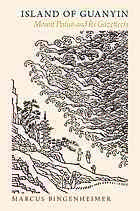
Island of Guanyin Mount Putuo and its gazetteers PDF
Preview Island of Guanyin Mount Putuo and its gazetteers
Island of Guanyin Budaluojia guanyin xianshen shengjing 補怛洛迦觀音現神聖境 (c. 1350). Island of Guanyin Mount Putuo and Its Gazetteers Marcus Bingenheimer 1 1 Oxford University Press is a department of the University of Oxford. It furthers the University’s objective of excellence in research, scholarship, and education by publishing worldwide. Oxford is a registered trade mark of Oxford University Press in the UK and certain other countries. Published in the United States of America by Oxford University Press 198 Madison Avenue, New York, NY 10016, United States of America. © Oxford University Press 2016 All rights reserved. No part of this publication may be reproduced, stored in a retrieval system, or transmitted, in any form or by any means, without the prior permission in writing of Oxford University Press, or as expressly permitted by law, by license, or under terms agreed with the appropriate reproduction rights organization. Inquiries concerning reproduction outside the scope of the above should be sent to the Rights Department, Oxford University Press, at the address above. You must not circulate this work in any other form and you must impose this same condition on any acquirer. Library of Congress Cataloging-in-Publication Data Names: Bingenheimer, Marcus, author. Title: Island of Guanyin : Mount Putuo and its gazetteers / Marcus Bingenheimer. Description: New York : Oxford University Press, 2016. | Includes bibliographical references and index. Identifiers: LCCN 2015034121 | ISBN 978–0–19–045619–1 (hardback : alk. paper) Subjects: LCSH: Buddhist temples—China—Putuo Shan Island. | Putuo Shan Island (China)— Description and travel. | Putuo Shan Island (China)—History. Classification: LCC BQ6345.P82 B56 2016 | DDC 294.3095124/2—dc23 LC record available at http://lccn.loc.gov/2015034121 9 8 7 6 5 4 3 2 1 Printed by Sheridan, USA CONTENTS List of Figures ix Acknowledgments xi Introduction 1 The Site and Its Gazetteers 2 Historical Overview 16 CHAPTER 1 “We Confucians”— Prefaces and Postscripts 29 Exhibit 1: We Confucians 32 Exhibit 2: Buddhist Rhetoric Toward Confucianism 35 Exhibit 3: The Late Ming Revival of Mount Putuo as Hidden in Prefaces and Postscripts 38 Exhibit 4: Yang Yongjian on Confucianism, Buddhism, and Death (c. 1698) 50 Conclusion 52 CHAPTER 2 Landscape and Map— Visual Representations of Mount Putuo 54 Exhibit 1: The Earliest Map of Mount Putuo (c. 1350) 56 Exhibit 2: The Maps in the Hou-T u Gazetteer (1590) 60 Exhibit 3: The “Twelve Views of Putuo” in the Qiu- Zhu Gazetteer (c. 1705) 66 Conclusion 76 CHAPTER 3 Foundation Legends and Miracle Tales 77 Exhibit 1: Origins 79 Exhibit 2: Apparitions of Guanyin at the Tidal Sound Cave 83 v Exhibit 3: The Miraculous Recovery of Mr. Wang 87 Exhibit 4: Zhu Jin “On Apparitions” (c. 1700) 89 Conclusion 93 CHAPTER 4 Elements of Landscape: Stay, Copy, Move, and Vanish 95 Exhibit 1: Stay— The Tidal Sound Cave 98 Exhibit 2: Copy— Fayu Temple and Brahma Voice Cave 99 Exhibit 3: Move and Vanish— The Sudhana Cave 104 Conclusion 106 CHAPTER 5 People, Biographies 108 Exhibit 1: Zhenxie Qingliao (1088– 1151) as First Abbot of Mount Putuo 110 Exhibit 2: Huang Dalai (d. 1690) and Lan Li (1649– 1720) as Patrons of the Early Qing Revival 114 Exhibit 3: Yitang Xinming (1655– 1745) and Bie’an Xingtong (1661– 1717) as Favored by the Kangxi Emperor 119 Conclusion 125 CHAPTER 6 Inscriptions 127 Exhibit 1: Shi Hao’s Verse Inscription on a Vision of Guanyin (1148 ce) 131 Exhibit 2: Zhou Yingbin’s Inscription for the “Three Masters of the Inner Palace” (c. 1607) 134 Exhibit 3: Kangxi’s Inscription “For the Fayu Temple on Mount Putuo in the Southern Sea” (1704) 138 Exhibit 4: Sun Yat-s en: “An Unexpected Event on Mount Putuo” (1916) 141 Conclusion 143 CHAPTER 7 The Poetic Landscape of Mount Putuo 145 Exhibit 1: Three Poems by Wu Lai (c. 1324) 148 Exhibit 2: Tu Long’s “Twelve Famous Views of Mount Putuo” (c. 1589) 150 Exhibit 3: Zhou Yingbin’s Poem for Abbot Rujiong (1607) 155 Exhibit 4: The Twelve Views in Zhu Defeng’s “The Famous Sights of Putuo” (1830) 158 Conclusion 164 vi | Contents CHAPTER 8 Travelers and Pilgrims 166 Exhibit 1: Xu Jing’s “Route Book of the Embassy sent to Koryō in the Xuanhe Era” (1123) 169 Exhibit 2: Hou Jigao’s “An Account of a Journey to Mount Putuo” (1588) 171 Exhibit 3: Xiancheng’s “Knowing the Paths of Pilgrimage” (1826) 181 Conclusion 187 Conclusion 188 Things Learned 188 Things Obscured 189 Conventions and Abbreviations 191 Notes 195 Bibliography 241 Index 261 Contents | vii FIGURES 2.1 Map of Mount Putuo, c. 1589 61 2.2 Detail Maps of the Tidal Sound Cave (right) and the Puji Temple, c. 1589 62 2.3 Detail Map of the Fayu (Haichao) Temple, c. 1589 63 2.4 Overview of Mount Putuo 67 2.5 Guanyin arrives on Mount Putuo 69 2.6 Legend of the Sister- in- Law 69 2.7 The Tidal Sound and the Brahma Voice Caves 69 2.8 The Pantuo Stone 69 2.9 The Fahua Cave 72 2.10 The Immortal’s Well 72 2.11 Watching the sun rise from the morning tide 72 2.12 Walking on Thousand- Step Beach 72 2.13 Waves of clouds at Peak Hua 75 2.14 On Guangxi Peak after snowfall 75 2.15 Listening to the bell near Baotuo Pagoda 75 2.16 Watching the moon in the lotus pond 75 6.1 Moya in the calligraphy of Hou Jigao—“ Buddha Land between Sea and Sky” (haitian foguo 海天佛國) 129 ix
